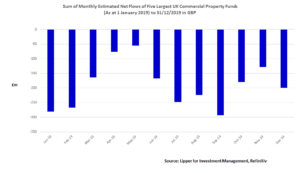It has recently been announced that the high-profile suspension of the M&G Property Portfolio will continue in order to allow time for liquidity in the vehicle to be increased.
The travails of UK funds which invest in direct commercial property have been apparent since before the Brexit vote took place in 2016. Investors have been spooked by the potential implications for the asset class by a “hard-Brexit.” This has been compounded by poor returns (see Figure 2., below) as a struggling retail sector continues to be affected by on-line disruption (retail constitutes around 30% of the commercial property market).
Lipper data reveals that outflows in the five largest UK-based commercial property funds have been considerable with some £2.3 billion coming out of these funds during 2019.
Figure 1. Estimated monthly net flows of the five largest UK-based commercial property funds

Source: Lipper for Investment Management, Refinitiv
Why invest in commercial property?
Investors are attracted to commercial property funds primarily because they tend to offer a good yield. Consider the aforementioned M&G fund – its historical yield as of November 2019 was 4.3%.
Also, commercial property funds have a low historical correlation to other asset classes, so they act as a strong portfolio diversifier. It is also an asset class which is tangible and visible. Many investors fail, however, to recognize that it is the relative illiquidity of this asset class which drives its benefit as a diversifier.
Mark to market does not equal liquidity
Commercial property funds currently are marked to market daily, yet the asset class is highly illiquid. This system works when times are normal. Typically, around 3% holding in cash in a fund is enough to meet day-to-day withdrawals from clients. However, in an atypical environment, property, unlike equities, cannot be sold off quickly. It is a lumpy, time consuming asset class in which to deal.
We’ve been through this before
Illiquidity events are not uncommon in this asset class. Commercial property funds were severely tested after before and during global financial crises, and there have been several liquidity squeezes on the asset class since then, notably in 2016 just after the Brexit vote.
Fund managers have learnt from these experiences. Lot sizes in funds have reduced, and portfolios tend to be more highly diversified across different regions. However, fund managers today cannot simply hold lots of cash as a preemptive solution to contagion events. Many investors desire a fully invested mandate with low cash drag. It’s a delicate demand for the portfolio manager.
Figure 2. 3-year performance of UK real estate indices (to 31/12/2019) in GBP

Source: Lipper for Investment Management, Refinitiv
Investor expectations are key
As my colleague Detlef Glow highlighted late last year, other countries have different approaches to the liquidity problem inherent in property funds. Germany for example, has used regulation to protect investors in property funds. In Australia, direct property is often packaged into syndicates with specific lock-in periods. Clients know that they cannot access their investment for several years.
It is the daily pricing of these funds which I believe is the root cause of the problem. Investors often see commercial property as a cash proxy and are perhaps misled by the “assurance” that this is reflected in daily pricing.
Clearly there is further education required here which is recognized by the UK Regulator pronouncement in September 2019.
Market events ebb and flow…
Brexit is a very unusual market event, but it is set to resolve itself given that there is a new pro-Brexit government in the UK with a large majority.
Certainly, the outlook for retail assets is tough, but this could change, and opportunities in other sectors will present themselves. All investments are subject to these market vagaries and commercial property is no exception.
Normality should prevail
My personal view is that these funds are robust enough to weather this current storm. They survived the global financial crisis, and “bricks and mortar” assets will always hold appeal for investors who want to diversify away from securities. The asset class has a compelling yield profile and property fund managers have learnt many lessons about liquidity management.
The suspension of any mutual fund is disconcerting to an investor who is directly affected. Let’s not forget though that this is an important mechanism to protect remaining investors and prevent asset disposals at fire sale prices.
In the meantime, investors need to understand what they are investing in and why they invested there in the first place. The temptation to associate daily pricing with liquidity needs to be overcome.
Lipper delivers data on more than 265,000 collective investments in 61 countries. Find out more.
Disclaimer:
This material is provided for as market commentary and for educational purposes only and does not constitute investment research or advice. Refinitiv cannot be held responsible for any direct or incidental loss resulting from applying any of the information provided in this publication or from any other source mentioned. Please consult with a qualified professional for financial advice. The author is invested in the M&G Property Portfolio.




